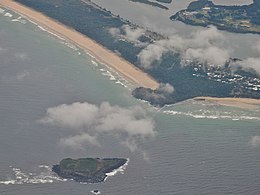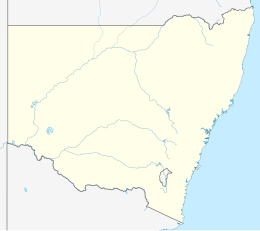Cook Island, formerly Cooks Island, Turtle Island and Joong-urra-narrian, is an island in the Australian state of New South Wales located on the state's north coast about 600 metres (2,000 ft) north-east of Fingal Head and 4 kilometres (2.5 mi) south-east of the town of Tweed Heads.[2]: 1, 2
Native name: Joong-urra-narrian | |
|---|---|
 Aerial view of Cook Island and Fingal Head, New South Wales | |
| Etymology | James Cook[1] |
| Geography | |
| Location | Coral Sea[1] |
| Coordinates | 28°11′54″S 153°35′04″E / 28.19833°S 153.58444°E[1] |
| Area | 4.6 ha (11 acres)[2]: 2 |
| Highest elevation | 24.8 m (81.4 ft)[2]: 4 |
| Administration | |
| state | New South Wales |
| Local government area | Tweed Shire |
| Demographics | |
| Population | 0 |
| Additional information | |
| Time zone | |
| • Summer (DST) | |
Description edit
Geology and topography edit
Cook Island is formed of “rocks from the Lismore Basalt Group, formed by lava flows from the Mount Warning Shield Volcano approximately 20 million years ago.”[2]: 2 The Island is a “protrusion of eroded basalt” of a maximum height of 24.8 metres (81 ft) above sea level and topped with a plateau. The western side of the island has a “gentle” slope while the remaining sides are “sheer cliffs” dropping to “low-lying rock shelves”. The top of the island and its western side are overlaid by a “shallow cover of topsoil.” A “semi-permanent freshwater basin” is located in the island's northern side.[2]: 2
Climate edit
In 2011, the average annual rainfall was reported as being 1,470 millimetres (58 in).[2]: 2
Access edit
Access to the island is considered to be not “easy” by the NSW National Parks and Wildlife Service because of the “exposed rocky nature” of the island's coastline and “frequently rough sea conditions.” Access is not promoted to “protect roosting birds and the nest burrows of wedge-tailed shearwaters which are fragile and can easily collapse under foot traffic.”[2]: 7, 8
Flora and fauna edit
Flora edit
As of 2011, there were twenty five native plant species which occupied, in part, three distinct habitats - “elevated locations; rocky crevices; and lower sites at the base of cliffs.”[2]: 5
Fauna edit
As of 2011, vertebrate animals were represented by 25 species of birds and two reptile species. These included 12 bird species listed as migratory species under the Environment Protection and Biodiversity Conservation Act 1999 and seven fauna species listed as threatened in New South Wales.[2]: 5, 6
History edit
Aboriginal history edit
Cook Island is located within the area historically occupied by the "Minjungbal people of the Bundjalung nation." Also, the island is the subject of "traditional knowledge" held by the Githabul and Yugambeh aboriginal people. As of 2011, while the Government of New South Wales did not know of any sites on the island of significance to Aboriginal people, the Aboriginal community did know of a "number of Aboriginal mythological stories" and of "some sites" associated with the island. For example, the island is known by the "Coodjinburra clan of the Bungjalung people" as Joongurra-Narrian which translates as "the place of pelicans".[2]: 7
European history edit
The first recorded European sighting of Cook Island was made by the English navigator James Cook, who sighted the coast of Fingal Head in 1770.[3] Cook charted the coastline of the island, but made no attempt at settlement.[4] Cook then continued sailing north along the eastern coast of Australia and named two nearby landmarks, Mount Warning and Point Danger, after he was nearly shipwrecked there.[3][4]
In 1823, English explorer John Oxley anchored at the island to take refuge from southerly winds. Two crew members then visited the island and named it Turtle Island, after finding sea turtles and an unidentified shipwreck.[5][6] Five years later, British admiral Henry John Rous surveyed the Tweed River and named the island, Cook's Isle, the name that has persisted.[3][7]
Australian spearfisher Ben Cropp reported the sighting of a European vessel, wrecked on the island in the 16th century.[8] In 2008, two fishermen, Joel Coombs and Malcolm Anable, were rescued from nearby the island, and later hospitalised, after they were thrown overboard as a result of their boat overturning.[9][10]
In 1970, the name Cook Island was officially assigned to the island, replacing Cooks Island.[1]
Since 1998, the island has been managed by the New South Wales Department of Environment and Climate Change and since 2004, by the Department of Primary Industries, as well.[11][12] It is under the jurisdiction of the Tweed Shire Council, who hold annual clean-up events.[11]
Protected areas status edit
The entirety of Cook Island has been the subject of protected area status since 1959 and since 1967, it has been located within the Cook Island Nature Reserve. The waters adjoining the island have been located within the Cook Island Aquatic Reserve since 1998.[2]: 2
References edit
- ^ a b c d e "Cook Island - Geographical Names Register Extract". Geographical Names Board of New South Wales. NSW Government. 24 December 1970. Retrieved 17 September 2019.
- ^ a b c d e f g h i j k Cook Island Nature Reserve, Plan of Management (PDF), NSW National Parks and Wildlife Service, Part of the Department of Environment, Climate Change and Water, 2011, ISBN 978-1-74293-205-7, retrieved 17 September 2019
- ^ a b c "Fingal Head". The Age. Melbourne: Fairfax Media. 8 February 2004. Retrieved 10 July 2009.
- ^ a b Cook, James (16 May 1770). The Endeavour Journal. National Library of Australia. Retrieved 10 July 2009.
- ^ Oxley, John Joseph William Molesworth (31 October 1823). Item 2/8093. State Records Authority of New South Wales.
- ^ Field, Barron (1825). Geographical memoirs on New South Wales. J. Murray. Retrieved 10 July 2009.
Barron Field's Geographical Memoirs.
- ^ Daley, Louise (1967). "Rous, Henry John (1795–1877)". Australian Dictionary of Biography. Vol. 2. National Centre of Biography, Australian National University. ISSN 1833-7538. Retrieved 10 July 2009.
- ^ Cropp, Ben (1964). Shark Hunters. Adelaide, South Australia: Rigby Ltd.
- ^ "Tweed River fishermen rescued after boat flips". The Courier-Mail. News Corporation. 18 October 2008. Retrieved 10 July 2009. [dead link]
- ^ "Men clung to boat for hours". The Courier-Mail. News Corporation. 18 October 2008. Retrieved 10 July 2009.
- ^ a b "Marine debris clean-up at Cook Island Aquatic Reserve". New South Wales Department of Environment and Climate Change. 3 October 2008. Retrieved 10 July 2009. [dead link]
- ^ "Cook Island". New South Wales Department of Primary Industries. 2 July 2004. Retrieved 10 July 2009. [dead link]
